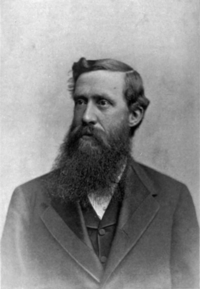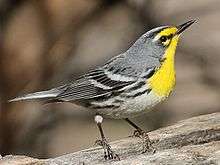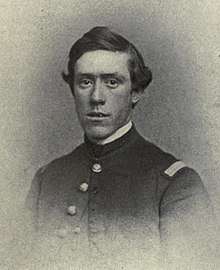Elliott Coues
| Elliott Coues | |
|---|---|
 Elliott Coues | |
| Born |
September 9, 1842 Portsmouth, New Hampshire |
| Died |
December 25, 1899 (aged 57) Baltimore, Maryland |
| Nationality | American |
| Alma mater | Columbian University |
| Scientific career | |
| Fields | Ornithology |
Elliott Coues (/ˈkaʊz/; September 9, 1842 – December 25, 1899) was an American army surgeon, historian, ornithologist and author.[1]
Biography
Elliott Ladd Coues was born in Portsmouth, New Hampshire to Samuel Elliott Coues and Charlotte Haven Ladd Coues.[2] He graduated at Columbian University, (now, George Washington University) Washington, D.C., in 1861, and at the Medical school of that institution in 1863. He served as a medical cadet in Washington in 1862–1863, and in 1864 was appointed assistant-surgeon in the regular army, and assigned to Fort Whipple, Arizona. While there was not yet any legal provision for divorce under its laws, the 1st Arizona State Legislature granted Coues an annullment of his marriage to Sarah A. Richardson.[3]
In 1872 he published his Key to North American Birds, which, revised and rewritten in 1884 and 1901, did much to promote the systematic study of ornithology in America. He was a founding member of the American Ornithologists' Union in 1883.[4] His work was instrumental in establishing the currently accepted standards of trinomial nomenclature – the taxonomic classification of subspecies – in ornithology, and ultimately the whole of zoology. During 1873–1876 Coues was attached as surgeon and naturalist to the United States Northern Boundary Commission, and from 1876 to 1880 he was secretary and naturalist to the United States Geological and Geographical Survey of the Territories, the publications of which he edited. He was lecturer on anatomy in the medical school of the Columbian University from 1877 to 1882, and professor of anatomy there from 1882 to 1887.[5]
He was a careful bibliographer and in his work on the Birds of the Colorado Valley he included a special section on swallows and attempted to resolve whether they migrated in winter or hibernated under lakes as was believed at the time:
I have never seen anything of the sort, nor have I ever known one who had seen it; consequently, I know nothing of the case but what I have read about it. But I have no means of refuting the evidence, and consequently cannot refuse to recognize its validity. Nor have I aught to urge against it, beyond the degree of incredibility that attaches to highly exceptional and improbable allegations in general, and in particular the difficulty of understanding the alleged abruptness of the transition from activity to torpor. I cannot consider the evidence as inadmissible, and must admit that the alleged facts are as well attested, according to ordinary rules of evidence, as any in ornithology. It is useless as well as unscientific to pooh-pooh the notion. The asserted facts are nearly identical with the known cases of many reptiles and batrachians. They are strikingly like the known cases of many bats. They accord in general with the recognized conditions of hibernation in many mammals.
— Birds of the Colorado Valley (1878), Chapter XIV.[6]
He resigned from the army in 1881 to devote himself entirely to scientific research. He was a founder of the American Ornithologists' Union, and edited its organ, The Auk, and several other ornithological periodicals. He died in Baltimore, Maryland.[5]
Grace's warbler was discovered by Elliott Coues in the Rocky Mountains in 1864. He requested that the new species be named after his 18-year-old sister, Grace Darling Coues, and his request was honored when Spencer Fullerton Baird described the species scientifically in 1865.

In addition to ornithology he did valuable work in mammalogy; his book Fur-Bearing Animals (1877) being distinguished by the accuracy and completeness of its description of species, several of which were already becoming rare. Odocoileus virginianus couesi, the Coues white-tailed deer is named after him.
Spirituality
Coues took an interest in Spiritualism and began speculations in Theosophy. He was a friend of Alfred Russel Wallace and they had attended séances with the medium Pierre L. O. A. Keeler.[7]
He felt the inadequacy of formal orthodox science in dealing with the deeper problems of human life and destiny. Convinced by the principles of evolution, he believed that these principles may be capable of being applied in psychical research and he proposed to use it to explain obscure phenomena such as hypnotism, clairvoyance and telepathy.[8] He claimed to have witnessed levitation of objects and developed a theory to explain the phenomena.[9]
Coues joined the Theosophical Society in July, 1884.[10] He visited Helena Blavatsky in Europe. He founded the Gnostic Theosophical Society of Washington, and in 1890 became the president of the Theosophical Society. He later became highly critical of Blavatsky and lost interest in the Theosophical movement.[8]
Coues wrote an attack on Blavatsky entitled Blavatsky Unveiled! in The Sun newspaper on July 20, 1890. The article prompted Blavatsky to file a legal suit against Coues and the newspaper but it was terminated as she passed away in 1891.[11] He fell out with Theosophical leaders such as William Quan Judge and was expelled from the Theosophical Society in June, 1899 for "untheosophical conduct".[10][11] Coues retained interest in oriental religious thought and later studied Islam.[10]
Publications

Among the most important of his publications are:
- A Field Ornithology (1874);
- Birds of the North-west (1874);
- Monographs on North American Rodentia, with Joel Asaph Allen (1877);
- Birds of the Colorado Valley (1878);
- A Bibliography of Ornithology (1878–1880, incomplete);
- New England Bird Life (1881);
- A Dictionary and Check List of North American Birds (1882);
- Biogen: A Speculation on the Origin and Nature of Life (1884);
- The Daemon of Darwin (1884);
- Can Matter Think? (1886);
- Neuro-Myology (1887);
- Blavatsky Unveiled! (1890)
- Rural Bird Life of England, with Charles Dixon (1895).
Coues also contributed numerous articles to the Century Dictionary, wrote for various encyclopaedias, and edited:
- Journals of Lewis and Clark (1893);
- The Travels of Zebulon M. Pike (1895);
- New Light on the Early History of the Greater Northwest: The Manuscript Journals of Alexander Henry, Fur Trader of the Northwest Company and of David Thompson, Official Geographer and Explorer of the Same Company, 1799-1814 (1897);
- Forty Years A Fur Trader on the Upper Missouri: The Personal Narrative of Charles Larpenteur 1833-1872 (1898).
On the Trail of a Spanish Pioneer: the Diary and Itinerary of Francisco Garces (Missionary Priest), New York, Francis P. Harper, 1900
References
- ↑ Smith, Alfred Emanuel (January 13, 1900). "A Great Ornithologist". The Outlook. 64: 98. Retrieved 2009-07-30.
- ↑ Victor, Frances F. (1 June 1900). "Dr. Elliott Coues". The Quarterly of the Oregon Historical Society. 1: 192.
- ↑ Acts, Resolutions and Memorials, Adopted by the First Legislative Assembly of the Territory of Arizona
- ↑ "The American Ornithologists' Union". Bulletin of the Nuttall Ornithological Club. VIII (4): 221–226. October 1883.
- 1 2 Chisholm 1911.
- ↑ Allen, J.A. (1909). "Biographical memoir of Elliott Coues" (PDF). National Academy of Sciences Biographical Memoirs. 6: 395–446.
- ↑ Slotten, Ross A. (2004). The Heretic in Darwin's Court: The Life of Alfred Russel Wallace. Columbia University Press. pp. 388-389. ISBN 978-0-231-13011-0
- 1 2 Marble, C. C. (1900). The Late Dr. Elliott Coues. Birds and All Nature: February, 1900.
- ↑ Cutright, Paul Russell; Brodhead, Michael J. (2001). Elliott Coues: Naturalist and Frontier Historian. University of Illinois Press. p. 302. ISBN 978-0252069871
- 1 2 3 Bowen, Patrick D. (2015). A History of Conversion to Islam in the United States, Volume 1: White American Muslims Before 1975. Brill. p. 149. ISBN 978-90-04-29994-8
- 1 2 Dimolianis, Spiro. (2011). Jack the Ripper and Black Magic: Victorian Conspiracy Theories, Secret Societies and the Supernatural Mystique of the Whitechapel Murders. McFarland. pp. 106-107. ISBN 978-0-7864-4547-9
- Attribution

External links
| Wikisource has original works written by or about: Elliott Coues |
- Works by Elliott Coues at Project Gutenberg
- Works by or about Elliott Coues at Internet Archive
- Auk 1884 Letter "Trinomials are necessary"
- Elliott Coues at Find a Grave
- National Academy of Sciences Biographical Memoir
- Curtis, Charles A. Army Life in the West (1862-1865). CreateSpace Independent Publishing Platform, April 20, 2017. ISBN 978-1545458785.
| Wikimedia Commons has media related to Elliott Coues. |